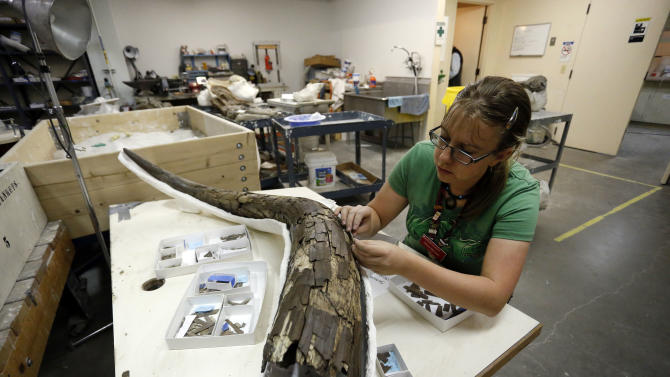 A trove of
ancient bones from gigantic animals discovered in the Colorado mountains
is providing scientists with a fascinating look at what happened about
120,000 years ago when the Earth got as warm as it is today.
A trove of
ancient bones from gigantic animals discovered in the Colorado mountains
is providing scientists with a fascinating look at what happened about
120,000 years ago when the Earth got as warm as it is today.
Evidence left
behind by mastodons, mammoths, giant sloths and huge bison — along with
insects, plants, pollen and other animals — offers a glimpse at how
ancient animal adapted to climate change.
Among
their findings: The warmer weather allowed forests to reach about 2,500
feet farther up the mountainside than today's tree line, which is about
11,500 feet above sea level at the Snowmass site. Forests also may have
been denser, and smaller trees and grasslands might have been more
widespread amid drier conditions.
A
team of 47 scientists has been studying material unearthed four years
ago near Snowmass, a town just outside Aspen, when a bulldozer was
enlarging a reservoir. The researchers published their first big batch
of data in the journal Quaternary Research in November.
"The
site is spectacular because it has a single continuous pile of sediment
from the most recent interglacial period," about 120,000 years ago,
when conditions were similar to the present, said Ian Miller, chairman
of the Earth Sciences Department at the Denver Museum of Nature and
Science. He is co-director of the museum's Snowmastodon Project, which
is sifting through the material.
"It's a beautiful record of the last time it was as warm or warmer than it is today," he said.
The information gives scientists solid data to check their climate models against.
It
also means that figuring out the impacts of human-produced greenhouse
gases combined with natural changes might be more complicated than
previously thought. "The point is ... if we haven't seen all the natural
variability in the system and we are causing warming, where are we
going?" Miller said.
The
Colorado site can point to clues about how life adapts to climate change
— but it doesn't answer the question, according to a climate scientist
not working on the Snowmass site.
"It
shows an example of a world that's that warm and shows us some manifest
examples of how animals react to that," said Ted Scambos, lead
scientist at the National Snow and Ice Data Center at the University of
Colorado. "What we're headed for is kind of a different situation where
we're turning the knob way up on climate in a very short period of
time."
The reservoir where the
bones were found was originally a natural lake and sits on a ridge
about 9,000 feet above sea level. The sediment and bones provided a
record of about 85,000 years, from 140,000 years ago to 55,000 years
ago.
The site yielded 35
mastodons, male and female, young and old. Researchers also found about
50 other species, including mammoths, giant sloths about the size of
today's grizzly bears, and bison that were half again as large as the
modern-day versions.
The site
didn't produce any information about why animals became extinct, but it
did provide hints about what their lives were like, Miller said. For
example, mastodon tusks grow a little each year, producing rings like
trees do, he said. The size of each ring indicates whether times were
good or bad.
"When it's stressful, they grow very little, and when it's nice, they grow a lot," Miller said.
The
bones are at the Denver Museum of Nature and Science and sediment
samples are at a USGS site in the Denver suburb of Lakewood. Studies
will likely continue for years, Miller said.

No comments:
Post a Comment